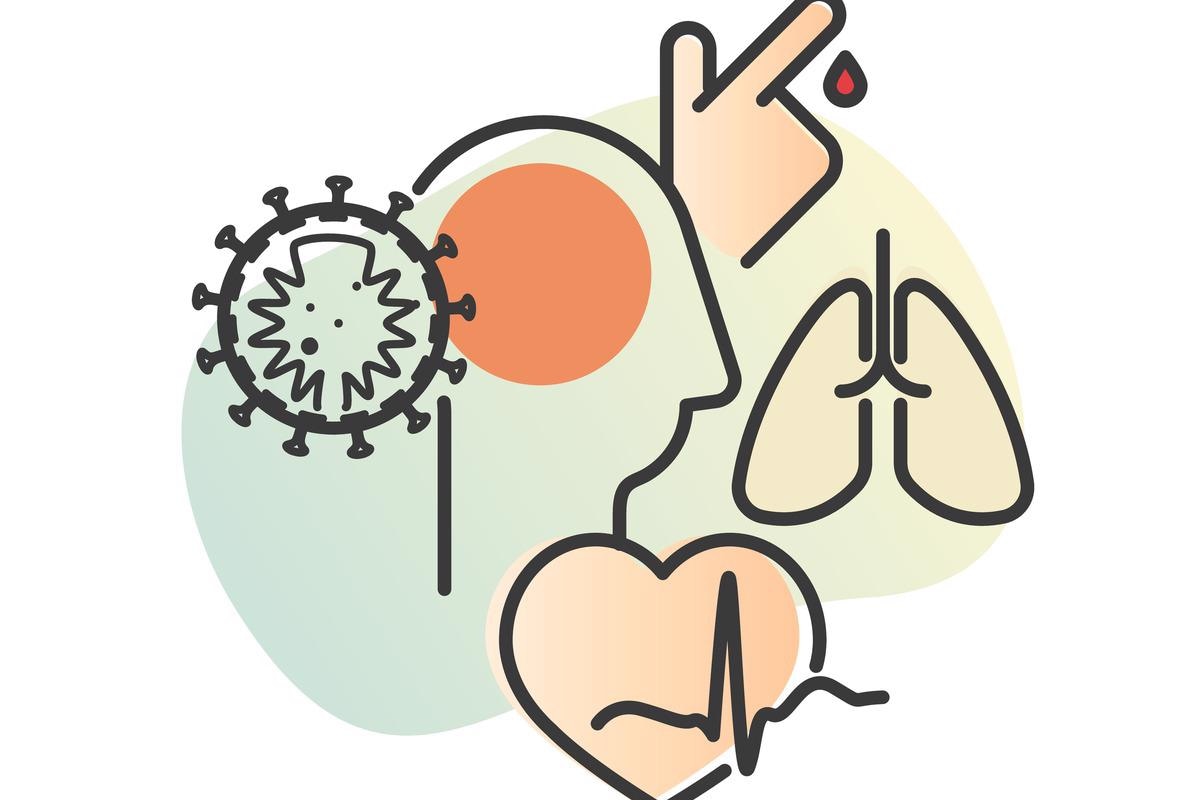Introduction
Concomitant disease: co-morbidity and multi-morbidity
Diabetes: an example of a primary illness that causes several concomitant diseases
Incidence of concomitant illnesses
Polypharmacy for concomitant diseases
Challenges
References
Further reading
A concomitant illness exists at the same time as another. The word concomitant means to accompany or associate. Individuals who possess a concomitant illness, usually have a primary illness; the presence of the primary illness can complicate the diagnosis and treatment of the concomitant illness.
 Image Credit: Gorodenkoff/Shutterstock
Image Credit: Gorodenkoff/Shutterstock
Concomitant disease: co-morbidity and multi-morbidity
In the medical setting, the presence of concomitant disease is usually termed multi-mobility or comorbidity, though there is a distinction between the two terms.
While both terms refer to the occurrence of multiple chronic conditions occurring in the same individual, the term comorbidity refers to the combined effect of additional conditions around/ in response to an index chronic condition. In multi-morbidity, there is no such index condition to which the occurrence of other conditions is referred. Instead, no condition holds priority over another.
In the case of comorbidity, the focus on the specific illness remains central to treatment, which is considered complicated by the presence of additional health problems. Interestingly, no standardized guidelines to measure or assess multimorbidity are available. Healthcare professionals that treat multimorbid patients face several problems related to screening and diagnosis and what is considered to be a condition versus a benign occurrence or drug reaction in the individual.
Diabetes: an example of a primary illness that causes several concomitant diseases
Concomitant Is a ubiquitous term that can be applied to a range of diseases. However, the concomitant illness tends to arise in primary illnesses which compromises the individuals' immune system. A notable example of this is type 2 diabetes, considered the most frequent chronic metabolic disease worldwide. Chronic hyperglycemia results in the widespread damage of several organ systems, posing a considerable health challenge and economic burden on the individual on a societal scale. The prevalence, lifetime risk, and concomitant comorbidities (illnesses) affect the disease burden.
Associated concomitant complications and illnesses include retinopathy, peripheral neuropathy, and autonomic neuropathy.
The co-occurrence of multiple diseases inevitably leads to the use of several drugs used to manage each of the individual illnesses; this condition is known as polypharmacy. Over the past two to three decades, problems related to aging, multimorbidity caused by concomitant illnesses, and polypharmacy have become a global healthcare concern. This reflects the shift in patient admission to internal medicine wards, where patients who primarily complained of illnesses affecting only one organ or system on now replaced by elderly people with multiple chronic diseases.
Incidence of concomitant illnesses
This is in part, due to huge shifts in developments in health technology which enable more accurate diagnosis of several subclassifications of diseases, as well as specialists of internal medicine, such as cardiology, pulmonary, gastroenterology, etc. Alongside this, advancements in treatment and healthcare have resulted in the efficacious treatment of a range of diseases, which has extended the average life span.
Indeed, one in six people worldwide is aged 65 years or over, and by 2050, this is expected to increase to one in four. Those aged over 80 are considered the fastest expanding population and are expected to reach approaching 30% of the overall population in the richest nations by 2050.
With the increasing opportunity to age, there is an increased risk of developing multiple chronic diseases, comorbidities, disabilities, frailty, and social isolation. The incidence of concomitant illnesses in the elderly has been estimated to be between 55% and 98%, occurring most frequently in the very old, women, and those considered to be of low socioeconomic status.
While multimorbidity often involves the concomitant occurrence of two or more diseases, the combination, distribution, and development of different types of disease, known as clustering, remains to be fully understood. Alongside this, the mechanisms that lead to the concomitant occurrence of disease, as well as the natural history of these multiple conditions, is necessary to inform treatment. This involves understanding genetic and biological factors, lifestyles, and socio-economic determinants, as well as their implications on multimorbidity.
 Image Credit: DesignPrax/Shutterstock
Image Credit: DesignPrax/Shutterstock
Polypharmacy for concomitant diseases
The use of multiple medications, known as polypharmacy, is a common occurrence in the elderly due to multiple concurrent and chronic health conditions. It is a growing subject of concern as there exists the potential for several drug-drug interactions. It is defined as taking five or more medications at the same time; when ten or more medications are taken at any one time, this is referred to as hyper-polypharmacy.
The prevalence of polypharmacy to deal with concomitant illness varies across populations and increases in likelihood with age. In a study of 1,742,336 older adults, the prevalence of polypharmacy was found to be 44%. In a report by the Scottish polypharmacy guidance, 11% of unplanned hospital admissions were attributed to the harm caused by polypharmacy; among these, half were considered preventable.
Clinically significant drug-drug interactions result in the reduced therapeutic effects of the drug and increase the occurrence of adverse drug reactions, with treatment outcomes being compromised.
An additional problem that results from multi- and comorbid conditions alongside emergency hospital admission, adverse drug events, and polypharmacy, are duplicate testing and the poor coordination of care. This is because healthcare workers have limited guidance and experience when conducting screening and making decisions for patients with both multi and comorbid conditions. In large part, medical training and clinical care are predominantly informed by evidence-based guidelines that are limited to either single diseases or single organ systems.
Clinical practice is becoming increasingly specialized, which exacerbates the problem of decisions for treatment being made on relatively narrow aspects of an individual’s health problems. At present, the systems of medical care are particularly poorly prepared to deal with patients who have concomitant diseases. This is especially pronounced in clinically relevant settings such as primary care (general practitioner) and services that are limited to the care of an aging population.

 Read Next: Comorbidities in Older Adults
Read Next: Comorbidities in Older Adults
Challenges
Concomitant diseases are becoming increasingly prevalent with an aging population and developments in disease management and treatment. Despite the impact of medical and clinical advances which have greatly improved the prognosis and quality of life of individuals, there exists a growing problem brought about by concomitant conditions, that obscure treatment decisions and increase the potential for adverse events due to polypharmacy. Moreover, the ability to make appropriate and evidence-based treatment is confounded by a lack of specialist knowledge and lack of guidelines.
As such, the cost of care remains high in concomitant diseases, due to high rates of primary and secondary care consultations in addition to unplanned hospital admissions brought on by polypharmacy. The combination of both physical and mental disorders further increases the complexity of care and the costs associated with it.
Patients with concomitant diseases have complex healthcare needs and face challenges in their management. These require a holistic approach by a generalist, which balances the competing priorities of specialist, single-disease, and target-based management approaches to multiple concomitant conditions which consider the overall wellbeing of the patient.
References
- Moffat K, Mercer SW. Challenges of managing people with multimorbidity in today's healthcare systems. BMC Fam Pract. 2015;16:129. doi: 10.1186/s12875-015-0344-4.
- Aggarwal P, Woolford SJ, Patel HP. Multi-Morbidity and Polypharmacy in Older People: Challenges and Opportunities for Clinical Practice. Geriatrics (Basel). 2020;5(4):85. doi:10.3390/geriatrics5040085.
- Stafford G, Villén N, Roso-Llorach A, et al. Combined Multimorbidity and Polypharmacy Patterns in the Elderly: A Cross-Sectional Study in Primary Health Care. Int J Environ Res Public Health. 2021;18(17):9216. doi: 10.3390/ijerph18179216.
- Calderón-Larrañaga A, Poblador-Plou B, González-Rubio F, et al. Multimorbidity, polypharmacy, referrals, and adverse drug events: are we doing things well? Br J Gen Pract. 2012;62(605):e821-6. doi: 10.3399/bjgp12X659295.
- NICE. Multimorbidity and polypharmacy. Available at: https://www.nice.org.uk/advice/ktt18. Last accessed February 2022.
Further Reading
Last Updated: May 31, 2022